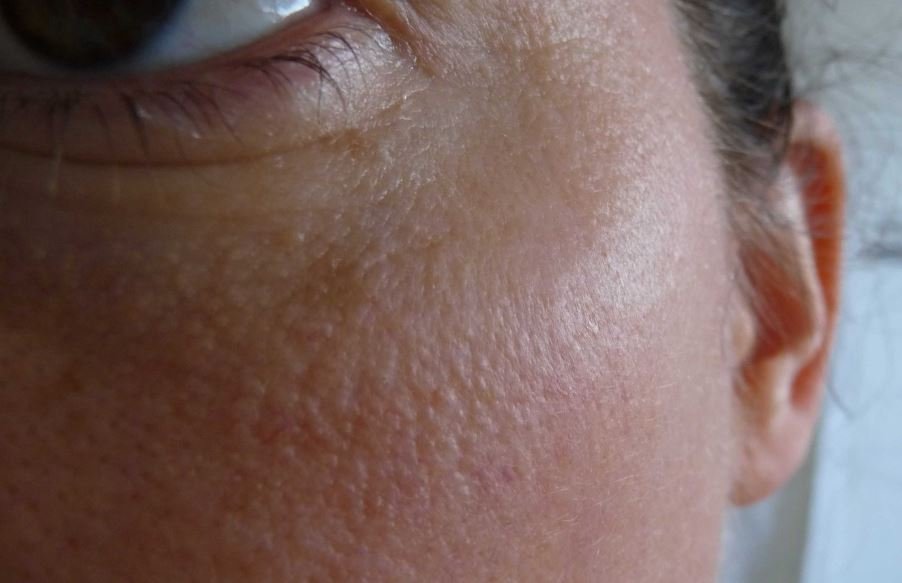

Of all body parts, the face is the most sensitive one and causes much concern to everyone. This is because it is very conspicuous. If plays an essential role in shaping one’s self-esteem. Due to this, it is quite frustrating to have a bumpy skin on the face.
Bumps on the face have become very popular today, may be due to changing lifestyle. A day won’t pass without hearing someone complain about them on this body part. Many people, moreover, are spending much time on the internet researching on how to get rid of bumpy skin on the face.

Why is my facial skin so bumpy?
If this article is addressing you, then join millions of people who are struggling with this condition.
These bumps which might be tiny, red, white or even colorless are unsightly. They appear on the forehead, alongside other areas across your face including cheeks, chin, on your jawlines or even neck areas. Because of them, one develops a rough bumpy skin on the face.
Many people, including you, are asking this question. These bumps are neither acne nor pimples. They may be either white or red. They may be small but are bigger bumps on face. They make the facial skin texture bumpy. What are they?
According to the clearskinessentials.com, tiny bumps all over your head may mean many things. Are they whiteheads or blackheads? Are they pimples? Many people stay in the dark concerning these issues.
In most cases, if you get small bumps on face that are not pimples. They are hard, white or pink and don’t pop easily. Also, they are hard and stubborn. They make you develop a bumpy rash around your face. They may be milia.
One is known as milia (plural milium). Some people call them oil seed or milk spots. They indicate a clogged sweat gland. They are cysts that are filled with keratin.
Milia are common in newborn babies. This, however, doesn’t mean that other ages are spared. They are found around the face but concentrated more around the nose and eyes.
According to medicalnewstoday.com, milia occur in the form of itchy or mini bumps and it results in a bumpy face.
There are five types of milia namely:
Neonatal Milia
They are common in many newborns. It is estimated that 50 % of all newborn babies develop bumpy faces due to milia. However, they don’t signify anything serious. Medics call them neonatal milia. They are mainly found around the nose.
However, they may affect the entire face. In some severe cases, they may be found inside the mouth. Generally, neonatal milia disappear naturally without any medication.
Primary Milia
This type of milia affects both children and adults. They manifest in the form of hard white bumps on face. They may appear for months and then disappear. It affects the face, especially the forehead, cheeks and around the eyelids. In some extreme cases, primary milia may be found in the genitals.
Milia en plague
In most cases, a bumpy skin on the face is due to milia en plague. It manifests in the form of white or tiny raised spots or dots. They then clump together, especially on the forehead and cheeks. They are usually raised above the skin level.
As a result, one develops a bumpy rash on face. It is believed that milia en plague comes hand in hand with other skin conditions such as lichen planus or pseudoxanthoma elasticum.
Multiple Eruptive Milia
Though this condition is rare; it is also characterized with many red or white bumps on face. If you are having red itchy ones in this area, then this is likely to be multiple eruptive milia.
Traumatic Milia- Dermatologists also call them secondary milia. If you have recently had an injury, then your skin might develop secondary milia. It manifests in the form of raised bumps on face.
According to skincarebyalana.com, the appearance of bumps including milia may signify a major skin problem. Commonly, milia indicate significant clogging.
Skin clogging occurs due to the accumulation of dust, dead skin cells or an infection. When all this matter gets clogged, they form cysts. These cysts come in the form white, red and small bumps on face.
The major question, therefore, is; what causes clogging. The following causes of clogging come up:
Skin damage by sun
Over-exposure to UV rays is a leading cause of clogged pores. When your skin is excessively exposed to sun’s rays, it becomes more leathery and thicker. This means that it becomes quite hard to get rid of dead skin cells. As these dead cells accumulate under the epidermis for some time, one develops bumps on face.
Shambolic exfoliation
You all know what exfoliation is. It is a common procedure for removing dead skin cells. There are many methods of exfoliation including chemical peels and microdermabrasion.
When it is shambolically conducted, dead skin cells get trapped in the epidermis. These trapped dead skin cells clog the pores. As a result, one develops bumps skin.
An adverse effect from makeup
Sometimes, the things that we apply on our face might irritate our skin. Some creams, moisturizers, and cleansers are the leading cause of itchy bumps on your facial area. These beauty products accumulate in the sweat pores, thus clogging them.
Poor cleansing
This is believed to one of the common cause. Regular cleansing is very essential. However, just note that cleansing should be done in the right way. After a long day at work, your skin gets exposed to dust and other irritants.
Moreover, makeup that stuck the whole day needs to be removed. Therefore, regular and thorough cleansing becomes essential. Failure to properly cleanse your face clogs your pores, thus it becomes bumpy.
Can you remove the bumps on your face? Can you make have a smooth skin again? For the significant number of people are still concerned about ways to get rid of bumpy skin on face, there are several ways.
It is possible to treat and prevent these bumps. Yes, you can even get rid of them even overnight. This can be done through medication and existing home remedies.
Below are some of the ways how you can give a try:
There are many other causes we omitted such as acne scars, injuries or trauma among other conditions.
References